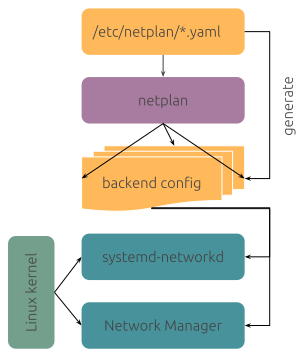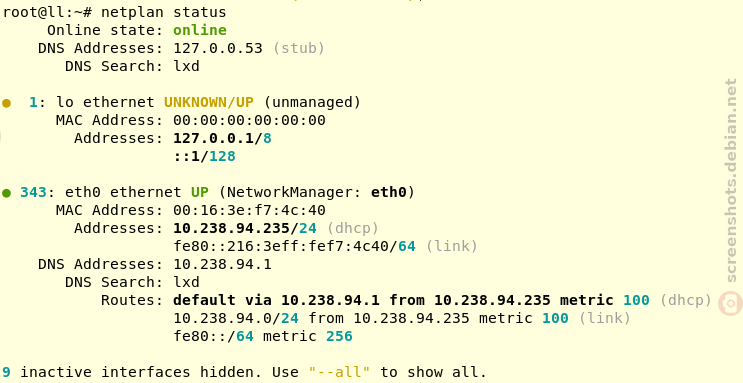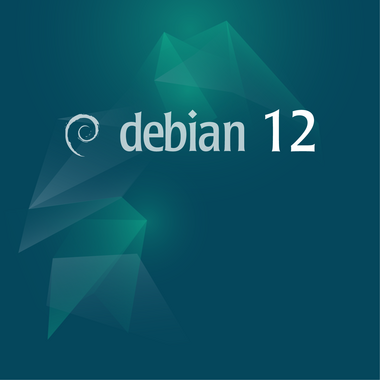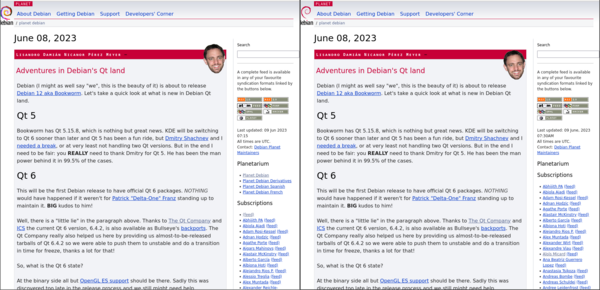Lukas M rdian: Netplan v0.107 is now available
I m happy to announce that Netplan version 0.107 is now available on GitHub and is soon to be deployed into a Linux installation near you! Six months and more than 200 commits after the previous version (including a .1 stable release), this release is brought to you by 8 free software contributors from around the globe.
Highlights
Highlights of this release include the new configuration types for veth and dummy interfaces:
Highlights
Highlights of this release include the new configuration types for veth and dummy interfaces:
network:
version: 2
virtual-ethernets:
veth0:
peer: veth1
veth1:
peer: veth0
dummy-devices:
dm0:
addresses:
- 192.168.0.123/24
...
Furthermore, we implemented CFFI based Python bindings on top of libnetplan s API, that can easily be consumed by 3rd party applications (see full cffi-bindings.py example):
from netplan import Parser, State, NetDefinition
from netplan import NetplanException, NetplanParserException
parser = Parser()
# Parse the full, existing YAML config hierarchy
parser.load_yaml_hierarchy(rootdir='/')
# Validate the final parser state
state = State()
try:
# validation of current state + new settings
state.import_parser_results(parser)
except NetplanParserException as e:
print('Error in', e.filename, 'Row/Col', e.line, e.column, '->', e.message)
except NetplanException as e:
print('Error:', e.message)
# Walk through ethernet NetdefIDs in the state and print their backend
# renderer, to demonstrate working with NetDefinitionIterator &
# NetDefinition
for netdef in state.ethernets.values():
print('Netdef', netdef.id, 'is managed by:', netdef.backend)
print('Is it configured to use DHCP?', netdef.dhcp4 or netdef.dhcp6)
Changelog:
- Support for dummy (
dummy-devices) interfaces (LP#1774203) by @daniloegea in #361
- Support for veth (
virtual-ethernets) interfaces by @daniloegea in #368
- Add Python bindings for libnetplan by @slyon in #385
- netplan: Handle command exceptions by @daniloegea in #334
- WPA3 (personal) support (LP#2023238) by @daniloegea in #369
- Add all the commands to the bash completion file (LP#1749869) by @daniloegea in #326
- New submodule for state manipulation by @daniloegea in #379
- commands/status: show routes from all routing tables by @daniloegea in #390
- cli:status: Make rich pretty printing optional by @slyon in #388
- libnetplan: expose dhcp4 and dhcp6 properties by @daniloegea in #394
- Expose macaddress and DNS configuration from the netdef by @daniloegea in #395
- libnetplan: expose the routes list in the netdef by @daniloegea in #397
- NetworkManager: Wireguard private key flag support by @daniloegea in #371
- Add a netplan_parser_load_keyfile() Python binding by @daniloegea in #351
- keyfile parser: add support for all tunnel types (LP#2016473) by @daniloegea in #360
- parse-nm:wg: add support for reading the listen-port property by @daniloegea in #372
- parse-nm: add support for VRF devices by @daniloegea in #398
- Vlan keyfile parser support by @daniloegea in #370
- Netplan docs rework by @daniloegea in #333 & #337
- docs: Add a short netplan-everywhere howto by @daniloegea in #325
- doc: make us of sphinx copybutton plugin by @slyon in #354
- doc: Add Ubuntu Code of Conduct 2.0 by @slyon in #355
- doc: Explanation about 00-network-manager-all.yaml by @slyon in #378
Bug fixes:
- Fix FTBFS on Fedora and refresh RPM packaging by @Conan-Kudo in #323
- parser: validate lacp-rate properly (LP#1745648) by @daniloegea in #324
- meson: use meson-make-symlink.sh helper script instead of install_symlink() by @slyon in #327
- netplan: cli: fix typo from unkown to unknown by @AristoChen in #328
- Handle duplication during parser second pass (LP#2007682) by @daniloegea in #329
- parse:ovs: Ignore deprecated OpenFlow1.6 protocol (LP#1963735) by @slyon in #332
- dbus: Build the copy path correctly by @daniloegea in #331
- tests: add new spread based snapd integration test by @mvo5 in #330
- Use controlled execution environment, to avoid failure if PATH is unset (LP#1959570) by @slyon in #336
- Some refactoring by @slyon in #338
- netplan: adjust the maximum buffer size to 1MB by @daniloegea in #340
- parse: use with systemd-escape by @daniloegea in #347
- docs: fix bridge parameters types and add examples by @daniloegea in #346
- vrfs: skip policies parsing if list is NULL (LP#2016427) by @daniloegea in #341
- networkd: plug a memory leak by @daniloegea in #344
- libnetplan: don t try to read from a NULL file by @daniloegea in #342
- nm: return if write_routes() fails by @daniloegea in #345
- parse: plug a memory leak by @daniloegea in #348
- parse: set the backend on nm-devices to NM by default by @daniloegea in #349
- parse: don t point to the wrong node on validation by @daniloegea in #343
- rtd: set the OS and Python versions explicitly by @daniloegea in #357
- Fix 8021x eap method parsing (LP#2016625) by @daniloegea in #358
- CI: update canonical/setup-lxd to v0.1.1 by @barrettj12 in #359
- CI: fix dch after adding the new 0.106.1 tag by @daniloegea in #364
- Provide frequency to wpa_supplicant when in adhoc mode (LP#2020754) by @yevmel in #363
- Improve the coverage of the memory leak tests by @daniloegea in #365
- Fix keyfile parsing of wireguard config when the prefix of allowed IPs is omited by @daniloegea in #366
- routes: fix metric rendering (LP#2023681) by @bengentil in #367
- CI: add DebCI integration test by @slyon in #362
- CI: initial NetworkManager autopkgtests by @slyon in #374
- parse-nm: handle cloned-mac-address special cases (LP#2026230) by @daniloegea in #376
- Improve autopkgtest stability with systemd 253 & iproute 6.4 by @slyon in #377
- Fixes for minor issues by @daniloegea in #380
- tests:integration: Adopt for systemd v254 (Closes: #1041310) by @slyon in #381
- parse: Downgrade NM passthrough warning to debug by @slyon in #384
- netplan.c: Don t drop files with just global values on set (LP#2027584) by @slyon in #382
- Fixing Coverity issues by @daniloegea in #383
- CLI: Refactoring to avoid namespace clash with public bindings by @slyon in #387
- tests: fix test coverage report with newer python-coverage by @daniloegea in #389
- github: add a scheduled action to run Coverity by @daniloegea in #391
- github: only run the coverity workflow on our repository by @daniloegea in #392
- Addressing a few issues found by coverity by @daniloegea in #393
- Wireguard fixes by @daniloegea in #352
- Fix a memory leak, an assert and an error message by @daniloegea in #350
- ovs: don t allow peers with the same name by @daniloegea in #353
- CI: make use of the canonical/setup-lxd action by @slyon in #356
network:
version: 2
virtual-ethernets:
veth0:
peer: veth1
veth1:
peer: veth0
dummy-devices:
dm0:
addresses:
- 192.168.0.123/24
...from netplan import Parser, State, NetDefinition
from netplan import NetplanException, NetplanParserException
parser = Parser()
# Parse the full, existing YAML config hierarchy
parser.load_yaml_hierarchy(rootdir='/')
# Validate the final parser state
state = State()
try:
# validation of current state + new settings
state.import_parser_results(parser)
except NetplanParserException as e:
print('Error in', e.filename, 'Row/Col', e.line, e.column, '->', e.message)
except NetplanException as e:
print('Error:', e.message)
# Walk through ethernet NetdefIDs in the state and print their backend
# renderer, to demonstrate working with NetDefinitionIterator &
# NetDefinition
for netdef in state.ethernets.values():
print('Netdef', netdef.id, 'is managed by:', netdef.backend)
print('Is it configured to use DHCP?', netdef.dhcp4 or netdef.dhcp6)- Support for dummy (
dummy-devices) interfaces (LP#1774203) by @daniloegea in #361 - Support for veth (
virtual-ethernets) interfaces by @daniloegea in #368 - Add Python bindings for libnetplan by @slyon in #385
- netplan: Handle command exceptions by @daniloegea in #334
- WPA3 (personal) support (LP#2023238) by @daniloegea in #369
- Add all the commands to the bash completion file (LP#1749869) by @daniloegea in #326
- New submodule for state manipulation by @daniloegea in #379
- commands/status: show routes from all routing tables by @daniloegea in #390
- cli:status: Make rich pretty printing optional by @slyon in #388
- libnetplan: expose dhcp4 and dhcp6 properties by @daniloegea in #394
- Expose macaddress and DNS configuration from the netdef by @daniloegea in #395
- libnetplan: expose the routes list in the netdef by @daniloegea in #397
- NetworkManager: Wireguard private key flag support by @daniloegea in #371
- Add a netplan_parser_load_keyfile() Python binding by @daniloegea in #351
- keyfile parser: add support for all tunnel types (LP#2016473) by @daniloegea in #360
- parse-nm:wg: add support for reading the listen-port property by @daniloegea in #372
- parse-nm: add support for VRF devices by @daniloegea in #398
- Vlan keyfile parser support by @daniloegea in #370
- Netplan docs rework by @daniloegea in #333 & #337
- docs: Add a short netplan-everywhere howto by @daniloegea in #325
- doc: make us of sphinx copybutton plugin by @slyon in #354
- doc: Add Ubuntu Code of Conduct 2.0 by @slyon in #355
- doc: Explanation about 00-network-manager-all.yaml by @slyon in #378





 A real sad state of affairs
A real sad state of affairs 






 As I blogged
As I blogged

 I write letters. The kind that are written on paper with a dip pen
I write letters. The kind that are written on paper with a dip pen  I ve also added a few pages for the addresses of my correspondents (and an index of the letters I ve exchanged with them), and a few empty pages for other notes.
Then I ve used my
I ve also added a few pages for the addresses of my correspondents (and an index of the letters I ve exchanged with them), and a few empty pages for other notes.
Then I ve used my  After printing (an older version where some of the pages are repeated. whoops, but it only happened 4 times, and it s not a big deal), it was time for binding this into a book.
I ve opted for Coptic stitch, so that the book will open completely flat and writing on it will be easier and the covers are 2 mm cardboard covered in linen-look bookbinding paper (sadly I no longer have a source for bookbinding cloth made from actual cloth).
After printing (an older version where some of the pages are repeated. whoops, but it only happened 4 times, and it s not a big deal), it was time for binding this into a book.
I ve opted for Coptic stitch, so that the book will open completely flat and writing on it will be easier and the covers are 2 mm cardboard covered in linen-look bookbinding paper (sadly I no longer have a source for bookbinding cloth made from actual cloth).
 I tried to screenprint a simple design on the cover: the first attempt was unusable (the paper was smaller than the screen, so I couldn t keep it in the right place and moved as I was screenprinting); on the second attempt I used some masking tape to keep the paper in place, and they were a bit better, but I need more practice with the technique.
Finally, I decided that for such a Victorian thing I will use an Iron-gall ink, but it s Rohrer & Knlingner Scabiosa, with a purple undertone, because life s too short to use blue-black ink :D
And now, I m off to write an actual letter, rather than writing online about things that are related to letter writing.
I tried to screenprint a simple design on the cover: the first attempt was unusable (the paper was smaller than the screen, so I couldn t keep it in the right place and moved as I was screenprinting); on the second attempt I used some masking tape to keep the paper in place, and they were a bit better, but I need more practice with the technique.
Finally, I decided that for such a Victorian thing I will use an Iron-gall ink, but it s Rohrer & Knlingner Scabiosa, with a purple undertone, because life s too short to use blue-black ink :D
And now, I m off to write an actual letter, rather than writing online about things that are related to letter writing.
 Shared library loading. ld.so seems to load shared libraries serially, looking through the load paths, looking through DT_LOADED sections, and looking up library paths or what's in ld.so.cache.
I thought I could scan DT_LOADED with just reading approx first 2kB of shared library, and get the full list of shared libraries first, and then readahead(2) the list of shared libraries available.
The result was that I could load blender binary slightly faster. blender spends about 300ms waiting for disk loading shared libraries and I could shorten it to about 100ms.
Shared library loading. ld.so seems to load shared libraries serially, looking through the load paths, looking through DT_LOADED sections, and looking up library paths or what's in ld.so.cache.
I thought I could scan DT_LOADED with just reading approx first 2kB of shared library, and get the full list of shared libraries first, and then readahead(2) the list of shared libraries available.
The result was that I could load blender binary slightly faster. blender spends about 300ms waiting for disk loading shared libraries and I could shorten it to about 100ms.
 I
I 






